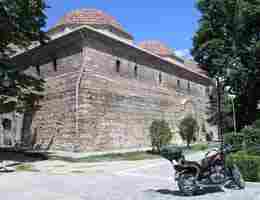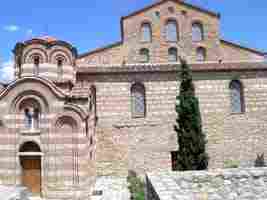.


Administrative Region : Central Macedonia
Regional unit : Serres
Serres (Greek: Σέρρες, older form: Σέρραι Sérrai) is a city in Macedonia, Greece. It is situated in a fertile plain at an elevation of about 70 m, some 24 km northeast of the Strymon river and 69 km north-east of the Macedonian capital, Thessaloniki. The Rhodope Mountains rise to the north and east of the city. The city is the capital of the peripheral unit of Serres and is situated at the eastern edge of Central Macedonia. Its municipal population was 76,240 in 2011.
Names
The Greek historian Herodotus mentions the city as Siris (Σίρις) in the 5th century BC. Theopompus refers to the city as Sirra (Σίρρα). Later, it is mentioned as Sirae, in the plural, by the Roman historian Livy. Since then the name of the city has remained in plural and by the 5th century AD it was already in the contemporary form as Serrae (Σέρραι). It is known as Ser in both Macedonian Slavic and Serbian, while in Bulgarian it is known as Syar (Сяр) or Ser (Сер), which can be deduced from the spelling before 1947 as 'Сѣръ', thus capturing both the 'ya' and 'e' sounds. The Katharevousa form for the name of the city was Sérrai (Σέρραι). It was known as Serez or Siroz in Turkish.
History
The chapel of the Aghioi Theodoroi old cathedral.
Serres became the site of a major fortress built by the Byzantine Empire to guard the empire's northern frontier and the strategic Rupel Pass into Bulgaria. It was seized by the Bulgarians in the 15th century. In 1196 in the battle of Serres the Byzantines were defeated by the Bulgarian Emperor Ivan Asen I. Nine years later in 1205 the Bulgarian Emperor Kaloyan defeated here an army of the Latin Empire and incorporated the town in the Bulgarian Empire. In 1256 it was captured by the Nicaean Empire. Serres fell to Serbia in the 1345 and became a capital of Stefan Dušan, the Serbian King. Dušan was so satisfied with the capture of the third major Byzantine city that he crowned himself Emperor of Serbs and Greeks. After his death his Empire fell into feudal anarchy and the Empress Consort Helena continued to govern Serres area from 1356. In 1365 she was ousted by Despot Jovan Uglješa Mrnjavčević, who forged a tiny but powerful mini-state in Serres. After the 1371 Battle of Maritsa, the Byzantines retook Serres under their control. Soon, however, in 1383 the Ottomans conquered it. Serres became a sanjak centre in the province of Rumelia between 1383-1826, and afterwards of Selanik Vilayeti between 1826-1912. In the aftermath of the battle of Lepanto in 1571, Turkish reprisals were directed at the Greek populations who had shown sympathy and had sporadically risen up across Greece. The metropolis of Serres was looted along with seven other churches, while land and land titles owned by the Monastery of St John the Baptist were confiscated.[1] At the end of the 18th C, Serres was cotton producing area, exporting 50,000 balls of cotton to Germany, France, Venice and Livorno.[2] The metropolitan (Greek Orthodox bishop) Gabriel founded in 1735 the Greek School of Serres which he directed until 1745. The school was maintained by donations from wealthy Greek merchants, among them Ioannes Constas from Vienna with 10,800 florins and the banker and tragic leader of the Greek revolution in Macedonia Emmanuel Pappas, who donated 1,000 Turkish silver coins. Minas Minoides taught Philosophy and Grammar in 1815-19. The school operated also in the period of the Greek revolution under Argyrios Paparizou from Siatista.[3]
In the early 20th century, the city became a focus of anti-Ottoman unrest, which resulted in the Ilinden-Preobrazhenie Uprising of 1903. A Bulgarian army, which was commanded by Georgi Todorov captured Serres during the First Balkan War on November 6, 1912 but was forced to withdraw by Greek forces commanded by Constantine I during the Second Balkan War on July 11, 1913. The city had to be completely rebuilt after being burned to the ground by the retreating Bulgarians[CN]. It was reoccupied by Bulgaria in both the First World War and Second World War and suffered further severe damage. In 1943, its Jewish population was deported to Treblinka and destroyed. Since the war, Serres has benefited from government-led programmes to develop its economy with foreign capital.
Municipality
The municipality Serres was formed at the 2011 local government reform by the merger of the following 6 former municipalities, that became municipal units:[4]
Ano Vrontou
Kapetan Mitrousi
Lefkonas
Oreini
Serres
Skoutari
Economy
The building of Serres' prefecture.
Serres is the capital of a primarily agricultural district and is an important trade centre for tobacco, grain, and livestock. Following the development of a government-sponsored manufacturing area in the late 20th century, it has also become a centre for the production of textiles and other manufactured items.
Landmarks
The statue of Emmanouel Pappas.
The church of Birth of Theotokos .
The city has forests, parks, non-gridded roads and squares. Serres stretches from the ruins of the castle up to the forested hills of Koula. On the road to Koula hills on Exochon (Exochi) Street, two parks, one is the Agioi Anargyroi Park founded near the downtown area. Night clubs and cafeterias are popular attractions, especially in the summertime.
Public Regional Theatre (Δημοτικό Περιφερειακό Θέατρο/Dimotiko Perifereiako Theatro)


Cuisine
In Serres, gyros and souvlaki are standard forms of Greek cuisine served in many restaurants and taverns. One delicacy that is truly unique to the region is akanes, which is a type of gourmet candy delight prepared according to a secret recipe since the beginning of the 20th century by the Roumbos family. Allegedly, Aristeidis Roumbos, the confectioner who invented this candy, disclosed the recipe to one of his loyal trainees, who then proceeded to establish a rival akanes business. Nevertheless, the Roumbos family, to this day, continues to produce this delight in their quaint workshop, which is reminiscent of life in the 1950s.
Neighborhoods
Katakonozi is one of the most prosperous neighborhoods of the city, and it is currently experiencing a real estate boom.
Population
Year Population
1981 46,317
1991 49,830
2001 56,145
2011 76,240
Notable residents
Emmanouel Pappas, leader of the Greek War of Independence in Macedonia
Konstantinos Karamanlis (8 March 1907 – 23 April 1998), leader of ERE (Greek: Ethniki Rizospastike Enosis) and founder of Nea Demokratia party, four time Prime Minister of Greece, the 3rd and 5th President of the Third Hellenic Republic.
Efstathios Tavlaridis, football player
Giorgos Kapoutzidis (1972), scriptwriter and actor
Glykeria, singer
Angelos Charisteas, football player
Gazi Husrev-beg, (1480–1541) bey in the Ottoman Empire
Halil Rifat Pasha 19th century Ottoman Grand Vizier
Sporting teams
Panserraikos - first national division(superleague)(2008-09 season) Website
Ofka Serres - Omilos Filon Klassikou Athlitismou) [1]
Twin cities
Bulgaria Blagoevgrad, Bulgaria
France Fosses, France
Israel Eilat, Israel
See also
East Macedonia and Thrace
Central Macedonia
References
"Sérrai." Encyclopædia Britannica, 2006.
"Sérrai, Siris, or Serres." The Columbia Encyclopedia, 2004.
^ Vakalopoulos, Constantinos A. (1996). Ιστορία του Βορείου Ελληνισμού -Μακεδονία. Εκδοτικός Οίκος Αδελφών Κυριακίδη. p. 80. ISBN 960343017Χ. "The metropolis of Serres was looted along with seven other churches, the Monastery of St John the Baptist, while land owned by the monastery was confiscated."
^ Vakalopoulos, Constantinos A. (1996). Ιστορία του Βορείου Ελληνισμού -Μακεδονία. Εκδοτικός Οίκος Αδελφών Κυριακίδη. p. 130. ISBN 960343017Χ. "At the end of the 18th C, Serres was cotton producing area, exporting 50,000 balls of cotton to Germany, France, Venice and Livorno ."
^ Vakalopoulos, Constantinos A. (1996). Ιστορία του Βορείου Ελληνισμού -Μακεδονία. Εκδοτικός Οίκος Αδελφών Κυριακίδη. pp. 131–2. ISBN 960343017Χ. "The metropolitan (Greek Orthodox bishop) Gabriel founded in 1735 the Greek School of Serres which he directed until 1745. The school was maintained by donations from wealthy Greek merchants, among them Ioannes Constas from Wien with 10,800 florins and the banker and tragic leader of the Greek revolution in Macedonia Emmanuel Papas, who donated 1,000 Turkish silver coins. Minas Minoides taught Philosophy and Grammar in 1815-19. The school operated also in the period of the Greek revolution under Argyrios Paparizou from Siatista"
^ Kallikratis law Greece Ministry of Interior (Greek)
|
Municipalities and communities of the Serres Prefecture Achinos | Alistrati | Amfipoli | Emmanouil Pappas | Irakleia | Kapetan Mitrousi | Kerkini | Kormista | Lefkonas | Nea Zichni | Nigrita | Petritsi | Proti | Rodolivos | Serres | Sidirokastro | Skotousa | Skoutari | Strymonas | Strymoniko | Tragilos |Visaltia Achladochori | Agkistro | Ano Vrontou | Oreini | Promachonas |
| Municipal unit Serres |
|---|
| Municipal Community Serres |
| Agios Ioannis (Άγιος Ιωάννης, ο) |
| Kato Metochi (Κάτω Μετόχι, το) |
| Krinos (Κρίνος, ο) |
| Xirotopos (Ξηρότοπος, ο) |
| Serres (Σέρρες, αι) |
| Community Elaionas |
| Elaionas (Ελαιών, ο) |
| Marmaras (Μαρμαράς, ο) |
| Moni Timiou Prodromou (Μονή Τιμίου Προδρόμου Σερρών, η) |
| Chrysopigi (Χρυσοπηγή, η) |
| Community Eptamyloi |
| Eptamyloi (Επτάμυλοι, οι) |
| Community Oinoussa |
| Oinoussa (Οινούσσα, η) |
| Chionochori (Χιονοχώρι, το) |
Greece :
A - B - C - D - E - F - G - H - I - J - K - L - M -
N - O - P - Q - R - S - T - U - V - W - X - Y - Z
| Ancient Greece
Science, Technology , Medicine , Warfare, , Biographies , Life , Cities/Places/Maps , Arts , Literature , Philosophy ,Olympics, Mythology , History , Images Medieval Greece / Byzantine Empire Science, Technology, Arts, , Warfare , Literature, Biographies, Icons, History Modern Greece Cities, Islands, Regions, Fauna/Flora ,Biographies , History , Warfare, Science/Technology, Literature, Music , Arts , Film/Actors , Sport , Fashion --- |
Retrieved from "http://en.wikipedia.org/"
All text is available under the terms of the GNU Free Documentation License






